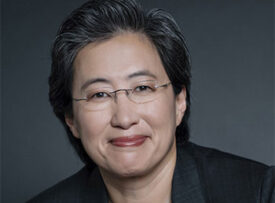Watch Lisa Su deliver the keynote at the 2022 IEEE Women in Engineering International Leadership Conference:
AMD’s CEO Lisa Su, IEEE Life Fellow, breaks through the Silicon Ceiling to become the first woman to receive IEEE’s highest semiconductor award.
When Lisa Su became CEO of Advanced Micro Devices in 2014, the company was on the brink of bankruptcy. Since then, AMD’s stock has soared—from less than US$2 per share to more than US$110. The company is now a leader in high-performance computing.
Su received accolades for spearheading AMD’s turnaround, appearing on Barron’s Top CEOs of 2021 list, Fortune‘s 2020 Most Powerful Women, and CNN’s Risk Takers.
 She recently added another honor: the IEEE Robert N. Noyce Medal. Su is the first woman to receive the award, which recognizes her “leadership in groundbreaking semiconductor products and successful business strategies that contributed to the strength of the microelectronics industry.” Sponsored by Intel, the Noyce Medal is considered to be one of the semiconductor industry’s most prestigious honors.
She recently added another honor: the IEEE Robert N. Noyce Medal. Su is the first woman to receive the award, which recognizes her “leadership in groundbreaking semiconductor products and successful business strategies that contributed to the strength of the microelectronics industry.” Sponsored by Intel, the Noyce Medal is considered to be one of the semiconductor industry’s most prestigious honors.
“To be honest, I would have never imagined that I would receive the Noyce award,” the IEEE Fellow says. “It’s an honor of a lifetime. To have that recognition from my peers in the technical community is a humbling experience. But I love what I do and being able to contribute to the semiconductor industry.”
Climbing the Leadership Ladder
Su has long had a practical bent. She decided to study electrical engineering, she says, because she was drawn to the prospect of building ha
rdware. “I felt like I was actually building and making things,” she says. She attended MIT, where she earned bachelor’s, master’s, and doctoral degrees, all in EE, in 1990, 1991, and 1994.
“It might surprise people that my parents would have preferred that I became a medical doctor,” she says, laughing. “That was the most well-respected profession when I was growing up. But I never really liked the sight of blood. I ended up getting a Ph.D., which I guess was the next best thing.”
Her interest in semiconductors was sparked at MIT. As a doctoral candidate, Su was one of the first researchers to look into silicon-on-insulator (SOI) technology, according to an MIT Technology Review article about her. The then-unproven technique increased transistors’ efficiency by building them atop layers of an insulating material. Today SOI is used either to boost the performance of microchips or to reduce their power requirements.
Su has spent most of her career working on semiconductor projects for large companies. Along the way, she evolved from researcher to manager to top executive. Looking back, Su divides her career path into two parts. The first 20 or so years she was involved in research and development; for the past 15 years, she has worked on the business side.
As CEO, she fosters a supportive and diverse culture at AMD. “What I try to do is ensure that we’re giving people a lot of opportunities,” she says. “We have some very strong technical leaders at AMD who are women, so we’re making progress. But of course it’s nowhere near enough and it’s nowhere near fast enough. There’s always much more that can be done.”
Motivating employees is part of her job, she says. “One of the things I believe is that great leaders can actually have their teams do 120 percent more than what they thought was possible,” she says. “What we try to do is to really inspire phenomenal and exceptional results.”
Important Association
Su joined IEEE while a student so she could access its technical content. “IEEE publications were just the most important,” she says. “As a student, you wanted to publish in an IEEE journal or present at an IEEE conference. We all believed it was where people wanted to share their research.
“I think IEEE is still the foremost organization for bringing researchers together to share their findings, to network, and to develop and build relationships,” she says. “I’ve met many people through my IEEE connections, and they continue to be close colleagues. It’s just a great organization to move the industry forward.”
Su donated the cash prize of $20,000 she received as part of the Noyce medal to the IEEE Women in Engineering Fund managed through the IEEE Foundation.
Content reposted with permission. Read the full article in The Institute




